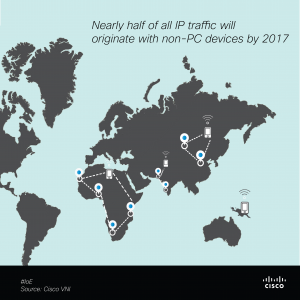Cisco Champions ask Challenging Questions. This is the first in a blog series presented by Carlos Dominguez and Jimmy Ray Purser.
I recently had an opportunity to sit down with our Cisco Champions to discuss a range of topics about the future of technology. Here’s a question of particular interest from Robert Novak:
“How can we use modern technology to serve the less tech-fortunate? I’m pretty happy with 70+ mbit of Internet coming into my home. But there’s still a lot of the country and the world wishing for 1mbit. Can mesh technologies provide a greater Internet safety net for people outside tech hubs? Can we combine this with device connectivity and give people a transparent Internet connection that’s as easy to manage as the refrigerator that connects to it, or something like that?”
We live in amazing times. The world is being “rebooted” and changed exponentially through technology – with the most disruption occurring through the power of connectivity. The speed of change in connecting people, data, processes, and things continues to grow at an unprecedented rate. Consider that only 10 years ago, there was no social media… and 10 years before that, we didn’t have the Internet…and web programming and mobile technologies didn’t even exist 20+ years ago!
These technologies now connect humanity in ways that we never could have imagined, removing barriers and transforming the way we interact and engage. The Internet is considered a “human right.” And intelligent connections are generating tremendous amounts of information and data in real-time, giving us knowledge and insights in the moment to make decisions that lead to our desired outcomes.
But, amazingly enough, 99% of the world is still unconnected. I emphatically agree with Robert that we must bridge that gap and make basic connectivity accessible to everyone – no matter where they live in the world. Connecting those previously unconnected will empower and affect lives in profound ways, adding tremendous value without huge amounts of bandwidth. There are many efforts already underway to help make that happen…..
- In Africa, basic 2G mobile technology is transforming and enriching the lives of farmers and fishermen. When they come back from their catch or from harvesting crops, they can look at a simple text message that shows market prices for produce or fish. With this critical information, they can make better decisions about where to sell their product.
- The Mobile Technology Programme from the Cherie Blair Foundation for Women connects 300M women in developing countries to create sustainable economic opportunities for entrepreneurs through the use of mobile phones and services. In Nigeria, for example, a service is delivered via SMS to mobile phones, providing valuable support and information tailored specifically for women entrepreneurs in that country. It is expected to reach 100,000 women by the end of 2013.
- Many remote places in the world don’t have access to critical weather alert information, so local communities are often ill-prepared for serious weather events. Through mobile technologies and partnerships, Earth Networks is reaching remote parts of the world, bringing weather forecasts and alerts to many of these locations for the first time.
 And this is just the beginning. According to our Cisco VNI data, the number of mobile-connected devices will exceed the number of people on our planet by the end of 2013 – and we’re expecting to reach 50 billion connected devices by 2020. This exponential growth means connectivity everywhere. It’s Moore’s Law in effect. And as technologies continue to evolve, they will also become more and more affordable. Imagine the impact this will have on connecting the world!
And this is just the beginning. According to our Cisco VNI data, the number of mobile-connected devices will exceed the number of people on our planet by the end of 2013 – and we’re expecting to reach 50 billion connected devices by 2020. This exponential growth means connectivity everywhere. It’s Moore’s Law in effect. And as technologies continue to evolve, they will also become more and more affordable. Imagine the impact this will have on connecting the world!
To Robert’s other point, mesh and wireless technologies have a role to play in this evolution. Their costs are continuing to go down, providing an affordable solution in bringing technology and connectivity to developing countries. And as long as there can be basic connectivity, the increased speed of those connections will follow.
The power and potential of connectivity is all around us. Like Robert, I look forward to the day when everyone has access to the knowledge and critical information they need to enhance and transform their lives.


CONNECT WITH US